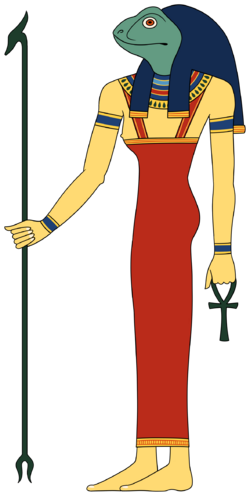Heqet facts for kids
Quick facts for kids Heqet |
|
|---|---|
 |
|
| Animals | Frog |
| Gender | Female |
| Consort | Khnum |
Heqet, also spelled Heket, was an important Egyptian goddess. She was known as a goddess of fertility. People often saw her as a frog, which was a strong symbol of new life in ancient Egypt. The yearly flooding of the Nile River brought new life to the land. This made the frog a perfect symbol for fertility. Heqet was often seen as the wife of the god Khnum. Some stories say she was the mother of Horus. Some experts also think her name might be linked to the Greek goddess Hecate.
About Heqet's Name
Heqet's name in ancient Egyptian was written as ḥqt. This word included a special sign that looked like a frog. Sometimes, her name was written with an extra part, ḥqtyt. This extra part helped show that she was a female deity. The way her name sounded in ancient Egypt might have been similar to "ha-KA-tat." This sound is one reason why some people believe her name could be connected to the Greek goddess Hecate.
Worship and Importance
People started worshipping Heqet a very long time ago. Her cult began during the Early Dynastic Period. This was one of the earliest times in ancient Egyptian history. Her name was found in the names of important people from the Second Dynasty. These people were buried in a place called Helwan. Heqet was also mentioned in ancient texts like the Pyramid Texts. Many early statues of frogs are believed to be images of Heqet.
Heqet was often seen as the wife of the god Khnum. Khnum was believed to create the bodies of new children. He would shape them on his potter's wheel.
In the famous Osiris myth, Heqet played a special role. She was thought to breathe life into the new body of Horus when he was born. Because of this, she became known as a goddess who helped with the last moments of birth. As the story of Horus's birth became linked with the idea of new life, Heqet's role also grew. She became connected to the idea of rebirth and new beginnings. People would wear amulets (charms) of Heqet. These amulets were believed to bring good luck and protection, especially during childbirth.
A temple dedicated to Horus and Heqet was found in a place called Qus. This temple was built during the Ptolemaic Period.
Heqet was strongly linked to fertility. She was connected to the final stages of the flooding of the Nile. This flood was very important because it helped crops grow. So, Heqet also became linked to the final stages of childbirth. This connection became very strong during the Middle Kingdom. She earned the title She who hastens the birth. This means she was believed to make childbirth easier and faster. Frog amulets that looked like Heqet were likely worn by women. They hoped these amulets would help them have a safe and easy delivery.
Images for kids
-
The god Khnum, with Heqet, shaping Ihy in a relief at Dendera Temple complex.
-
An Early Dynastic Period (around 3000 BC) frog statue at the Cleveland Museum of Art.
See also
 In Spanish: Heket para niños
In Spanish: Heket para niños



